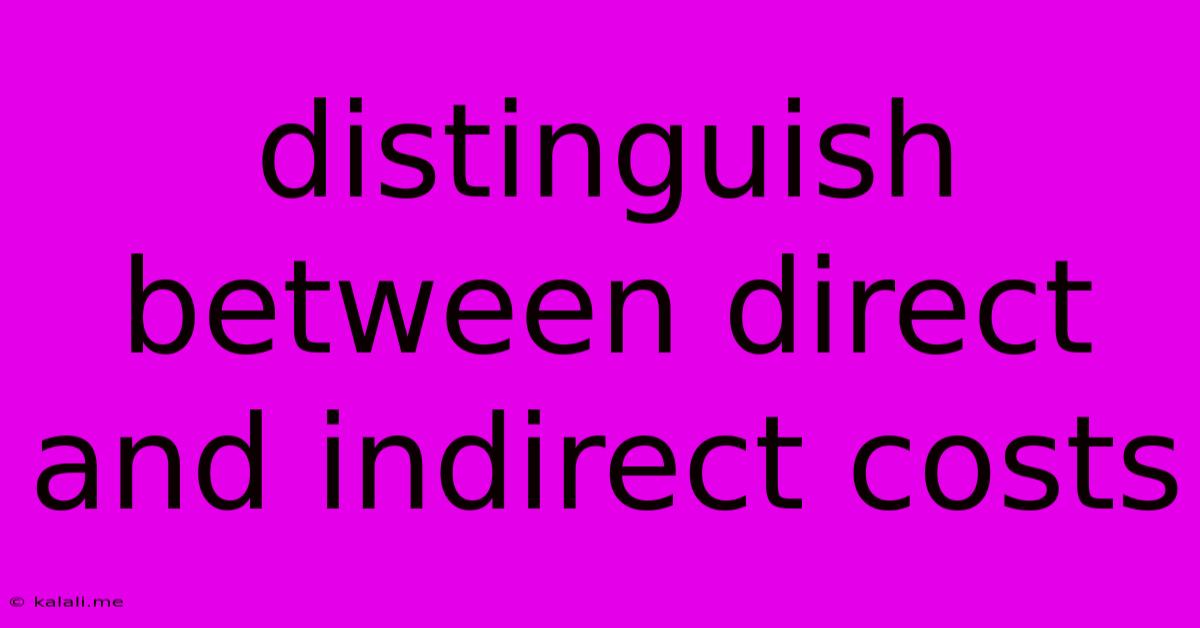Distinguish Between Direct And Indirect Costs
Kalali
Jun 15, 2025 · 3 min read

Table of Contents
Distinguishing Between Direct and Indirect Costs: A Comprehensive Guide
Understanding the difference between direct and indirect costs is crucial for accurate financial reporting, effective cost management, and informed business decision-making. This guide provides a clear explanation of each type, with practical examples to help you confidently differentiate them. Knowing this distinction allows for better budgeting, pricing strategies, and overall profitability analysis.
Direct Costs: These are costs that can be directly traced to the production of a specific good or service. They're easily identifiable and attributable to a particular product or project. Think of them as the costs that are directly involved in creating your product or providing your service.
Types of Direct Costs:
-
Direct Materials: These are the raw materials that become part of the finished product. Examples include wood for furniture, fabric for clothing, or ingredients for food. The cost of these materials is directly tied to the number of units produced.
-
Direct Labor: This represents the wages and salaries paid to employees who directly work on the production of goods or services. For example, the wages of assembly line workers, carpenters building furniture, or chefs preparing meals are all direct labor costs.
-
Direct Expenses: These are other costs directly attributable to the production process, such as the cost of tools used specifically for one project, or specialized machinery used to create a single product batch.
Indirect Costs (Overhead Costs): These costs are not directly traceable to the production of a specific good or service. They support the overall production process but aren't directly tied to a single product. These costs are often shared across multiple products or projects, making allocation a more complex process.
Types of Indirect Costs:
-
Factory Rent: The cost of renting or owning the building where production takes place.
-
Utilities: Electricity, gas, and water bills used in the production facility.
-
Depreciation: The decline in value of equipment and machinery used in production.
-
Insurance: Premiums paid for insurance covering the factory, equipment, or employees.
-
Maintenance and Repairs: Costs associated with maintaining and repairing factory equipment.
-
Supervisory Salaries: Salaries of managers and supervisors overseeing the production process.
-
Administrative Salaries: Salaries of administrative staff who support the overall operations of the business.
Key Differences Summarized:
| Feature | Direct Costs | Indirect Costs (Overhead) |
|---|---|---|
| Traceability | Easily traceable to specific products/services | Difficult or impossible to trace to specific products |
| Relationship to Production | Directly involved in production | Supports production but not directly involved |
| Examples | Raw materials, direct labor, direct expenses | Rent, utilities, depreciation, insurance, salaries |
| Cost Allocation | Simple and straightforward | Requires allocation methods (e.g., absorption costing) |
Why is this distinction important?
Accurate classification of costs is vital for several reasons:
-
Costing and Pricing: Understanding direct costs is essential for setting accurate product pricing that ensures profitability.
-
Budgeting and Forecasting: Accurately forecasting costs requires a clear understanding of both direct and indirect costs.
-
Performance Evaluation: Analyzing direct costs helps assess the efficiency of production processes.
-
Decision Making: Knowing the cost structure helps businesses make informed decisions about pricing, product development, and resource allocation.
By understanding the difference between direct and indirect costs, businesses can make more informed decisions, optimize their operations, and improve profitability. Remember that proper cost accounting and accurate allocation methods are key to managing these different cost categories effectively.
Latest Posts
Latest Posts
-
The Sum Of Three Consecutive Integers Is
Jun 15, 2025
-
Automatic Expansion Valves Are Good At Maintaining A Constant
Jun 15, 2025
-
Which Two Countries Share The Longest Border In The World
Jun 15, 2025
-
Which Is An Example Of An Input Device
Jun 15, 2025
-
What Is The First Half Of The Alphabet
Jun 15, 2025
Related Post
Thank you for visiting our website which covers about Distinguish Between Direct And Indirect Costs . We hope the information provided has been useful to you. Feel free to contact us if you have any questions or need further assistance. See you next time and don't miss to bookmark.